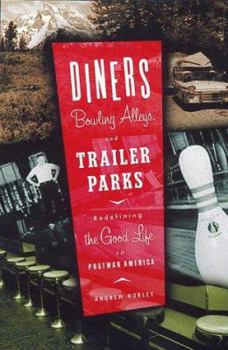Diners, Bowling Alleys, and Trailer Parks: Chasing the American Dream in Postwar Consumer Culture
Select Format
Select Condition 
Book Overview
The years immediately following the Second World War witnessed a dramatic transformation of America's working-class suburbs, driven by an unprecedented post-war prosperity and a burgeoning consumer... This description may be from another edition of this product.
Format:Hardcover
Language:English
ISBN:0465031862
ISBN13:9780465031863
Release Date:February 2001
Publisher:Basic Books
Length:432 Pages
Weight:1.39 lbs.
Dimensions:1.4" x 5.9" x 8.6"
Customer Reviews
4 ratings
Fascinating, Easy Read.
Published by Thriftbooks.com User , 16 years ago
I urge anyone to check this fascinating, brief snapshot of 20th century American culture. I've loaned this book to several friends, and they all loved it as well. I actually bought mine used for a couple of bucks. Well worth it.
Cultural icons and what they say about society
Published by Thriftbooks.com User , 19 years ago
The title of this book essentially describes the entire focus of this book; how three uniquely American icons: diners, bowling alleys, and trailer parks, and the history behind them, reflect the socio-economic and demographic history of the USA after WWII. Divided into five chapters, an intro, a conclusion, and one chapter for each cultural icon, the book goes to show how the birth and evolution of each of these three icons mirrors much larger changes within American society. For example, trailer parks came about to house the huge concentrations of labor formed by the rapid industrialization during and after WWII. As America suburbanized, trailer parks became stigmatized as backwards and overly affiliated with blue collar labor. They and their residents became targets of hostile legislation, negative stereotypes, and other slights. A similar trajectory is described for diners. Again their presence came about to serve the concentrations of industrial labor formed in the first half of the 20th century. But as America suburbanized, fast-food chains took over in the suburbs and leaving diners with essentially the scraps of the older cities. A different path is described for bowling alleys. Here, the technological advance of automatic pin setters allowed bowling alleys to change with the times and upgrade themselves to new, wealthier suburban tastes. Therefore, of the three cultural icons, only one, the bowling alley, is still a vibrant and solid fixture in the American landscape. All in all a good book. The final chapter wraps up with a synthesis of American 20th century economic and cultural history, and how this is intertwined with the history of diners, bowling alleys, and trailer parks. I recommend this book.
working class dreams in the consumer paradise
Published by Thriftbooks.com User , 21 years ago
Hurley offers an insightful, thought-provoking, and at times disturbing picture of three emblematic popular institutions of post-war America. While all came out of working class roots and emerged as popular features in the wider popular culture of the 1950s, each industry found different ways to negotiate its relationship with its working class roots and its aspiration for access to a wider mass market. Hurley shows how working class Americans, emerging from the economic trauma of poverty and the Great Depression, sought through consumer culture to redefine themselves as middle class, even as middle class Americans often created new kinds of fashion snobbery as a way of redefining the new aspiring working class/middle class as crass or vulgar. Hurley explores the emergence of the new mass market that emergence with relative working class affluence after the Second World War, while properly noting the limitations of that affluence. He also explores how this new mass consumer market, shaped by advertising constructs of domesticity and family togetherness, both limited, and even excluded women and minorities (especially African-Americans, who continued to be the target of the most vigorous economic discrimination and exclusion) through the 1960s and 1970s, even as the mass market ideal was crumbling under new challenges generated during the 1960s that sprang from many of the impulses unleased by American consumerism itself. This is a fascinating and indeed entertaining work. Yoy can learn a lot about the social and cultural history of diners, bowling alleys, and trailer parks, but beyond that, you can get a valuable insight into some of the larger forces that have shaped who we are as Americans, both for better and for worse.
Social history along the highway
Published by Thriftbooks.com User , 22 years ago
This is essentially a book of social history, although it brings together the disciplines of economic history, gender studies, architecture, and popular culture. Hurley discusses how diners, bowling alleys, and trailer parks reflected the social values of the 1950s and 1960s. The chapters on the three building types go into excruciating detail; for example, every nuance of diner design and operation is discussed and scrutinized for meaning. The book would have been improved if the author had covered more building types in the same number of pages.Hurley's overriding theme is laudable: On the outskirts of most towns, there is a region that constituted that community's "commercial strip" during the 1950s and 1960s, before America discovered fast food, shopping malls, and big-box stores. Most of us drive through these past-their-prime commercial strips every day, seeing nothing but obsolete buildings. Hurley points out that these obsolete commercial strips are the equivalent of archeological sites, speaking volumes about how family values have evolved during the past half-century.






